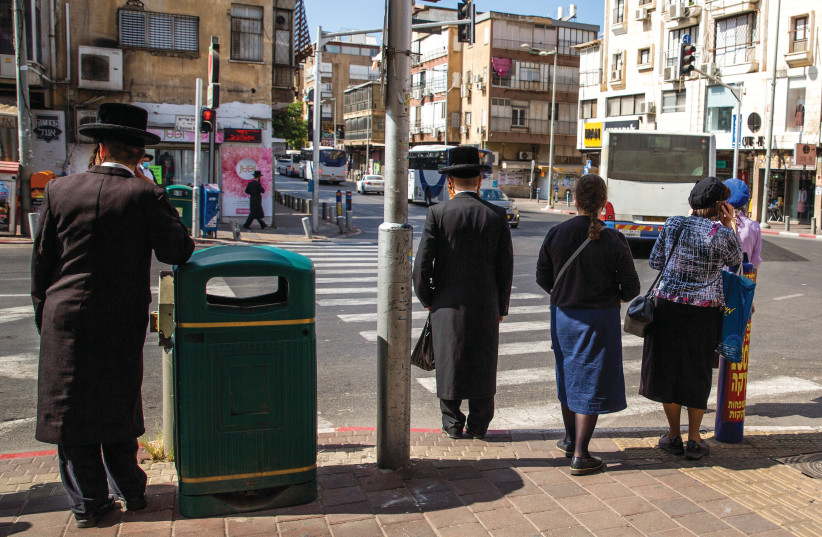When the High Court of Justice recently overturned the ministerial appointment of haredi Shas leader Arye Deri, a crowd of hundreds of Shas supporters gathered outside his home to express their dismay over the ruling.
Among the chants were claims that the High Court judges – all Jews of Ashkenazi descent – were once again discriminating against Jews of Mizrahi descent.
While there is no real evidence that ethnicity had any role to play in the High Court ruling, the decision, to many Mizrahi Jews, reinforced decades-old beliefs of systemic discrimination dating back to the establishment of the State of Israel.
These assertions have once again shone a spotlight on a painful and emotionally charged divide within Israeli society – the divide between Jews of European and American descent, and Jews of Asian or African descent.
In the 75 years of Israel’s short history, there has never been a Mizrahi judge heading the High Court. There has never been a prime minister of Mizrahi descent, and the vast majority of senior academics in the country are of Ashkenazi descent. These glaring omissions often serve as a basis for proof of the ongoing gaps and discrimination facing Mizrahi Jews in Israel.


On the other hand, there have been a number of IDF chiefs of staff of Mizrahi descent. Two of Israel’s presidents were of Mizrahi descent and there are many Mizrahi politicians holding senior government positions today. Also, many of the country’s leading cultural figures are of Mizrahi descent.
Nevertheless, and putting politics aside, the question remains: Are there still gaps between Jews of Mizrahi and Ashkenazi descent in Israel today? And if so, where and how do they manifest themselves?
The Magazine sat down with leading researchers and sociologists from around the country to gain a better understanding of the issue.
It is noteworthy that all the experts and researchers fully acknowledged that the first few decades of the State of Israel’s existence saw major gaps in practically all areas of life – financial, educational, geographical and cultural – between Jews of European or American descent, and Jews emigrating from Asia or Africa.
The educational and economic divide
“In many areas, the gaps between Jews of American or European descent and those of Asian or African descent have been eliminated or have diminished significantly,” Prof. Momi Dahan of the School of Public Policy and Government at The Hebrew University of Jerusalem, told the Magazine.
“Already by the end of the 1970s, we saw certain gaps between the two ethnic groups beginning to minimize – the gaps in the number of children, the age of people getting married, and the rate of mixed marriages began to continually increase,” he said.
While the gaps in these areas seemingly diminished, Dahan said that the financial and educational gaps were still very evident.
“It wasn’t until the mid-1990s that the gaps in education and salary began to diminish. This is a trend that is continuing today,” he said.
Dahan said Mizrahi Jews, especially women, were able to significantly and quickly minimize the gaps in higher education, which in turn led to a minimization of gaps in wages.
The latest data regarding the second generation, born to parents who immigrated to Israel, indicates that the educational and financial gap among women has almost vanished, Dahan noted.
“The financial gap among women of the two ethnic groups stands at around 5% when looking at the average salary before tax, while the gap among men stands between 10-15%. This is from data collected in the past five years,” he said.
He added that it is important to note that this data reflects the second generation, and not the third or fourth generations for which data has not been readily made available.
A more recent 2019 Tel Aviv University/Columbia University study of third-generation Mizrahim found similar trends in the minimization of educational gaps among the third generation when compared to the second generation.
“There is a puzzle,” Dahan said. “On the one hand, research and trends show a minimization of gaps in education and finances; but in the public sphere there is a dissonance, and the issue of Mizrahi Jews continues to come up.
“In terms of dry facts – the gaps between Ashkenazim and Mizrahim are trivial in Israel today. There are much more significant gaps, such as between Jews and Arabs, haredi and secular. These are real gaps that require immediate attention,” he added.
“In terms of dry facts – the gaps between Ashkenazim and Mizrahim are trivial in Israel today. There are much more significant gaps, such as between Jews and Arabs, haredi and secular. These are real gaps that require immediate attention.”
Momi Dahan
With regard to the ethnic divide, Dahan said he is optimistic.
“I see the minimization of the gaps in education, especially among women. We have to remember that this is a process, and it will take time. But eventually, in a few years we will see more Mizrahi women (and men) in higher level positions in academia and other areas,” he said.
However, he said he believes that the public discourse over the ethnic divide continues to be “self-defeating.”
“There is very good news regarding the reduction of gaps. It is important to build on these expectations for Mizrahim from the periphery. If they will know that gaps are minimizing, they will want to join in this success. But when public figures send messages that there are still gaps between the two ethnic groups and the Mizrahim are still lagging behind, this is a self-defeating message.”
While Dahan views the data on finance and education among the ethnic groups as a sign of a minimization of gaps, other researchers believe this is only one piece of the puzzle.
Lost history and identity
“The notion that the gaps between Ashkenazim and Mizrahim are based on economic status is something I completely disagree with,” Prof. Haviva Pedaya from the Department of Jewish History at Ben-Gurion University of the Negev and a researcher at the Van Leer Jerusalem Institute told the Magazine.
“The meaning of this is that if Mizrahim bridge the gaps in finance and become wealthy, then there would be no gaps,” she said. “But there is already an inherent gap with the lack of acknowledgment and division over the gaps between these two groups.”
The reason for this, explained Pedaya, lies in the systemic bias since the establishment of the state.
“Israel is a country of immigration. World Zionism was born in Europe, so all the conceptions and foundations of the state were based upon this worldview – it was the basis for the entire State of Israel, and it spread everywhere.”
Prof. Haviva Pedaya
“Israel is a country of immigration. World Zionism was born in Europe, so all the conceptions and foundations of the state were based upon this worldview – it was the basis for the entire State of Israel, and it spread everywhere,” she said.
Pedaya said this was a type of “colonialism” toward Jews of Asian and African descent.
“There was what is known as ‘exclusion from the book and routing to the periphery,’ which constituted historical and geographical discrimination,” she said. “This is the historical basis of the state, and since then there have been discussions about this issue in Israel, but nobody has ever instituted a real reform.”
She added: “The State of Israel has been around for 75 years, but still we do not teach the history of Sephardi Jewry. No education minister has said, ‘Let’s fix this, let’s rewrite the history books.’ This has never happened, and this is the basis for inequality.”
According to Pedaya, Jews of African and Asian descent are “a collective without a history.”
“They want to go back to their roots, to their history, to their collective story – and so long as they are denied this, they continue to feel as though they are not truly seen in Israeli society today,” she said.
Another important point, she noted, is that European history is centered on the individual, while Asian/African history is very community-centric.
“If you take the collective who believes their identity is lost, it doesn’t matter how much one may succeed. Once you have taken away the identity symbols and the history of the collective, they will continue to feel as though their own identity is without history,” she said.
This is one of the “missing pieces of the puzzle” and the reason, she asserted, that even Mizrahi Jews who are successful financially and who have reached top positions within Israeli society continue to bring up the ethnic divide.
“You cannot take away a person’s identity and collective history and then come and say, ‘What do you want? You’re rich, you’ve made it. So why are you still complaining?’”
Additionally, Pedaya said that many Mizrahi Jews are still living in poverty in the periphery and have not been able to escape this cycle.
“Discrimination is still happening today,” she said unequivocally. “I have heard so many stories from Mizrahi Jews who were discriminated against in every aspect of life, and there is empirical research that continues to show this is in fact the case.”
Still, Pedaya also remains optimistic about the future.
Recently, she served as head of the Council for Higher Education Committee for the promotion of Sephardic and Mizrahi Identity studies.
“We were able to pass a reform – which was very difficult to pass – for this area to become a recognized discipline in higher education,” she said. “It is only beginning this year and will likely take many years to bear the fruits of this decision. But it is an important step.”
She said that for real reform to take place, the history of Mizrahi Jews must be taught in parallel to the history of European and American Jews.
“We must teach the history of all Jews from the West to the East,” she said. “I really hope that we will be able to reach an understanding and a dialogue for the future so that these distinctions won’t last forever.”


Missing data and intersectionality
Progress is being made slowly. Another historical and very significant step in rectifying the gaps was made in 2022 when the Central Bureau of Statistics (CBS) decided, after decades of refrain, to publicize data on third and fourth generations of Ashkenazi and Mizrahi Jews.
“Mizrahim and Ashkenazim? This is a story from 50 years ago. It is not relevant today. Everyone is already mixed,” the former chief statistician at the CBS told Sigal Nagar-Ron of the Sapir Academic College. She had met with him in 2021 to promote the continued collection of data on inequality between immigrants from Asia and Africa, and on European and American immigrants of the third and fourth generation.
He denied her request.
However, Nagar-Ron pursued the issue and published an article in 2021 titled “National Statistics, Ethnic Categorization and Measuring Inequality in Israel,” detailing the importance of such data in continuing to measure gaps between these ethnic groups.
“I published this piece after years of trying to change the policy. Due to this, six months ago the new head of the CBS, Yoel Finkel, announced that they would provide statistics on the third generation,” Nagar-Ron told the Magazine.
This decision has been hailed and welcomed by researchers in the field.
“It is wishful thinking that there are no gaps, so we don’t need to measure them,” she said. “As a sociologist, one of the first lessons you learn is that once there are gaps, they perpetuate themselves – there is a reproduction of the gaps.”
Nagar-Ron said she continues to encounter these gaps today among the younger generations, whether among students at universities or women in the South who are unable to transfer their higher education degree into meaningful employment and even within academia.
“In a 2020 study we conducted at Sapir College, we found that in academia today, 70% of senior positions are held by Ashkenazim, while 19% are held by Mizrahim – less than 5% by Mizrahi women,” she said.
This is only one example. Nagar-Ron’s focus today is on “intersectionality” – a term used to describe the interconnectedness of identities, such as gender, race, class, ethnicity and so on, and how they apply to discrimination.
“I use this theoretical framework to understand what is happening in Israel,” she explained. Her latest research focused on collecting narratives of Mizrahi women in the South.
“They may now be educated, but they are still unable to find employment specifically because they are women and of Mizrahi descent and, as such, are discriminated against,” she said.
To that end, Nagar-Ron is a proponent of affirmative action in Israel.
“In terms of ethnicity, we must have affirmative action. Until then, there is no reason the gaps will close.”
She did, however, call out politicians for making “cynical use of this issue.”
“Politicians manipulate this divide all the time, and it is problematic. We don’t need to talk about feelings, but we do need to talk about empirical data.
“You can’t hold a serious discussion based on pronouncements and emotions. Once we have the empirical data, then let’s see if we really need to address the issue. If we do, then let’s address it.”
Yuval Livnat, director of the Adva Center, a progressive think tank that monitors inequality in Israeli society, agreed.
“Unfortunately, socioeconomic gaps between Mizrahi and Ashkenazi Jews still persist in 2023 Israel,” he told the Magazine. “Erosion of social services, governmental neglect of the country’s geographical periphery, and an enduring sense of cultural superiority by part of the Ashkenazi population hinder reconciliation and true equality of opportunities.”
Livnat presented numerous studies in all areas of Israeli society on the inequality and discrimination against Jews of Mizrahi descent, from education to the workforce to the housing sector.
One study found that on average, Ashkenazi applicants received 34% more callbacks from employers compared to Mizrahi applicants. Another study found that Mizrahim are more likely to be discriminated against in admission to nightclubs than their Ashkenazi counterparts.
“We still see, however, that in the ultra-Orthodox community, the gaps and discrimination are most visible,” Livnat said. “There is a clear divide that is systematically maintained in all areas of life, between ultra-Orthodox Jews of Mizrahi and Ashkenazi descent.”
Indeed, this article only touches upon a fraction of the complex history and modern-day divide between Mizrahi and Ashkenazi Jews. Many aspects of this issue were not addressed, due in part to a lack of data among the third and fourth generations – a historic blunder that is now being corrected. Mizrahi Jews were also unwilling to go on record openly and talk about their personal stories of discrimination.
However, the issue of the gaps between these two ethnic groups still remains at the core of Israeli social discourse, albeit oftentimes under the surface.
Perhaps Nagar-Ron summarized it best: “I understand that in Israel the issue of Mizrachi origin is taboo – nobody likes to talk about it. But if we don’t open this Pandora’s box and don’t talk about ethnicity as a political issue, many of the problems that are at the basis of our community will not be resolved.
“We need to turn this into an open discussion because only if we open this wound and let it breathe will we be able to heal.”
